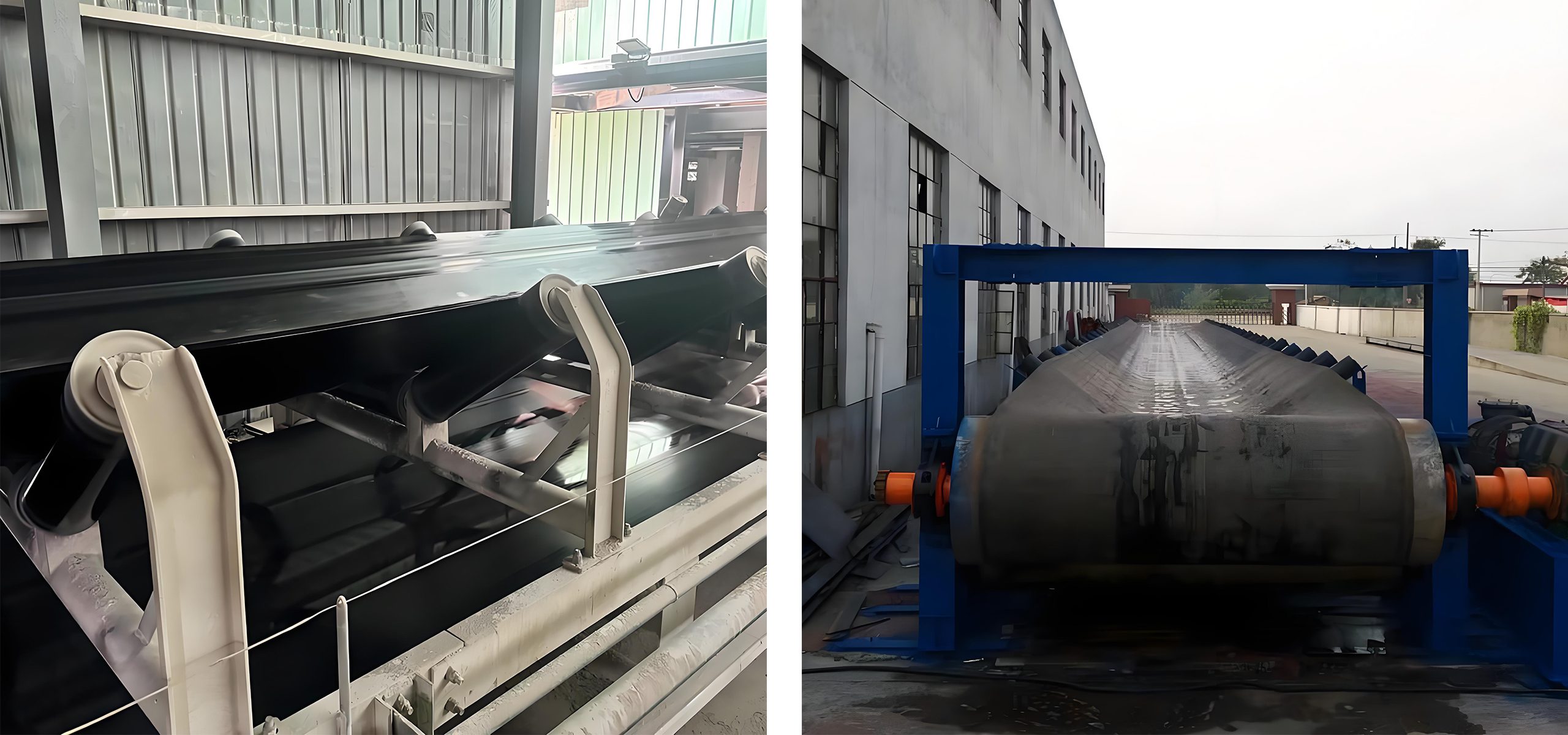يعد عدم محاذاة الحزام مشكلة شائعة وصعبة في تشغيل السيور الناقلة. ويكمن السبب الجذري لاختلال المحاذاة في صافي القوى الخارجية المؤثرة على السير في اتجاه العرض، والتي لا تساوي صفرًا، أو إجهاد الشد غير المتساوي المتعامد على عرض السير. يتسبب هذا الخلل في أن قوة رد الفعل من البكرات أو البراميل تمارس قوة جانبية على السير مما يؤدي إلى اختلال المحاذاة. تحلل هذه المقالة أسباب اختلال الحزام وتوفر تدابير تصحيحية فعالة.
أسباب اختلال الحزام
1. عدم محاذاة المراكز
قد لا تتم محاذاة الرأس والذيل والإطارات الوسطى بشكل صحيح. غالبًا ما يحدث هذا الاختلال في المحاذاة بسبب التركيب غير الصحيح، مما يتسبب في أن يكون الخط المركزي الطولي للسير غير متعامد على محور الأسطوانة، مما يؤثر على التشغيل.
2. وضع الأسطوانة غير صحيح
يجب تثبيت جميع البكرات بشكل عمودي على الخط المركزي للسير وموازية للمستوى الأفقي. إذا لم يتم استيفاء هذا الشرط، سينزاح السير إلى جانب واحد.
3. وصلة الحزام غير مناسبة
سواءً باستخدام الوصلات الميكانيكية أو الوصلات المفلكنة، فإن أي خلل في الوصلة يمكن أن يؤدي إلى شد غير متساوٍ على كلا الجانبين، مما يسبب اختلالاً في المحاذاة أثناء التشغيل.
4. إطار الأسطوانة المختل
يجب محاذاة الخط المركزي لمجموعة البكرات مع الخط المركزي لإطار الماكينة. الخطأ المسموح به لا يزيد عن 3.0 مم. إذا تم تركيب إطار الأسطوانة بشكل غير صحيح أو كانت البراغي مفكوكة، فقد يختل السير.
5. تلف الحزام
إذا كانت درجة التلف غير متناسقة على جانبي الحزام، فقد يتسبب ذلك في حدوث تمدد غير متساوٍ ويؤدي إلى اختلال في المحاذاة.
6. نقطة تصريف غير مناسبة
يمكن أن يؤدي التفريغ غير المتكافئ للمواد إلى توزيع غير متساوٍ للقوة على السير مما يؤدي إلى اختلاله. إذا كانت نقطة التفريغ خارج المركز، فيجب تعديلها على الفور.
7. الأثر الناجم عن انخفاض المواد
عندما تسقط المواد على الحزام، فإن وزنها والقصور الذاتي يمكن أن يتسبب في إزاحة الحزام.
8. المواد المتراكمة
يمكن أن تتراكم المواد اللزجة على البكرات أو الأسطوانات، مما يؤدي إلى شد غير متساوٍ ويسبب اختلالاً في المحاذاة.
9. زاوية الأسطوانة غير صحيحة
إذا كانت زاوية تركيب الأسطوانة غير دقيقة، فقد يتسبب ذلك في إزاحة السير في قسم الحمل.
10. مشكلات جودة الحزام
إذا كانت كثافة الحزام غير متساوية، فقد يؤدي ذلك إلى شد غير متساوٍ ويؤدي إلى اختلال في المحاذاة.
11. مشاكل في جهاز الشد
يمكن أن يؤدي التركيب أو الضبط غير الصحيح لجهاز الشد إلى شد غير متساوٍ ويسبب اختلالاً في المحاذاة.
12. الشيخوخة من الاستخدام طويل الأمد
بمرور الوقت، يمكن أن ترتخي الأحزمة بمرور الوقت، مما يزيد من خطر حدوث اختلال في المحاذاة.
13. ميل الإطار
إذا كان الإطار مائلاً، فيمكنه ممارسة قوة جانبية على الحزام.
14. اهتزاز المعدات
يمكن أن تتسبب الاهتزازات الشديدة أثناء التشغيل، وخاصة الحركة الشعاعية للبكرات، في اختلال السير.
15. نصف قطر الانحناء الصغير
إذا كان نصف قطر انحناء المقطع المقعر صغيرًا جدًا، فقد يرتفع السير أثناء بدء التشغيل.
التدابير التصحيحية لاختلال الحزام
لمعالجة الأسباب المذكورة أعلاه، يمكن تنفيذ التدابير التالية:
محاذاة الرأس والذيل والإطارات الوسطى: تأكد من محاذاة جميع المكونات الثلاثة على نفس خط الوسط.
وضع الأسطوانة الصحيح: تأكد من أن محور الأسطوانة عمودي على الحزام وموازٍ للمستوى الأفقي.
ضبط مفاصل الحزام: قم بإزالة أي وصلات غير صحيحة المحاذاة وتأكد من استقامتها.
إعادة محاذاة إطارات الأسطوانة: قم بتحريك إطار الأسطوانة على الجانب المختل وأعد ضبطه حسب الضرورة.
تعزيز الصيانة: افحص السير بانتظام وقم بإصلاح أو استبدال أي أجزاء تالفة على الفور.
ضبط نقطة التفريغ: تأكد من توسيط نقطة التفريغ على الحزام.
تصميم أدلة المواد المناسبة: تجنب السقوط المباشر للأجسام الكبيرة وتركيب بكرات عازلة عند نقطة التفريغ.
مسح المواد المتراكمة: الحفاظ على نظافة أسطح الأسطوانة والأسطوانة والحفاظ على تشغيل أجهزة التنظيف.
ضبط موضع مجموعة الأسطوانة: تعديل فتحات التثبيت بناءً على اتجاه المحاذاة غير الصحيحة.
اختر الشركات المصنعة ذات السمعة الطيبة: ضمان جودة المعدات وخدمة ما بعد البيع الجيدة.
تثبيت أجهزة الشد بشكل صحيح: تأكد من أن خط الوسط عمودي على محور الأسطوانة واتبع متطلبات التركيب.
إجراء عمليات تفتيش منتظمة: استبدل الأحزمة المتقادمة أو المشوهة على الفور.
ميل الإطار الصحيح: أعد تركيب الإطار للتأكد من استوائه.
تحديد مشاكل الاهتزازات ومعالجتها: حل أي مصادر لاهتزاز المعدات.
إضافة بكرات الضغط: تثبيت بكرات الضغط في المقاطع المقعرة لمنع السير من الرفع.

عند تشغيل السيور الناقلة، من الضروري مراقبة اختلال الحزام عن كثب. يعد تحديد الأسباب في الوقت المناسب وتنفيذ التدابير المناسبة أمرًا أساسيًا للحفاظ على كفاءة واستقرار التشغيل. من خلال اتباع هذه الإجراءات التصحيحية، يمكنك تقليل المخاطر المرتبطة باختلال المحاذاة بفعالية وتعزيز كفاءة الإنتاج.لمزيد من الاستفسارات أو المساعدة، لا تتردد في الاتصال ب اتصل بنا! نحن هنا لمساعدتك ودعمك.

